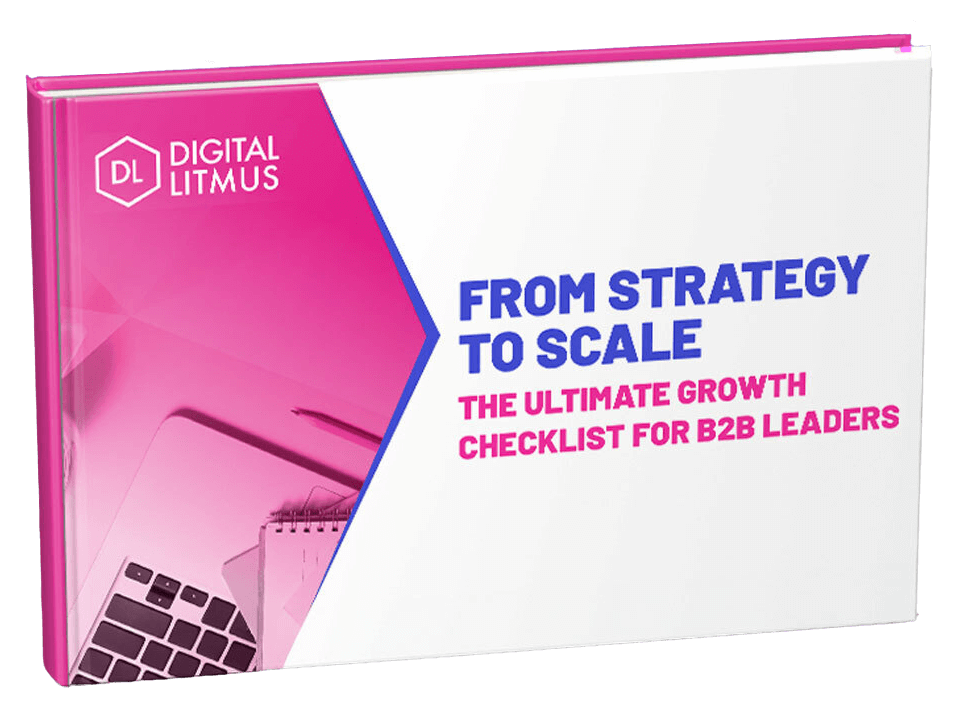Having a strong online presence is crucial for business success. Most marketers are aware that their website serves as the virtual face of the company, representing its brand, products, and services to potential customers. However, creating or refreshing a website can often feel like a tedious, expensive, and resource-draining process.
Many businesses try to make impactful improvements to their websites only once a year or even less frequently. This lack of regular updates and optimisation can hinder a website's ability to effectively support the company’s sales function and drive business growth. This is where Growth-Driven Design comes in—a smart and agile approach that offers a better way to create and maintain an effective website that aligns with your business goals.
.png?width=650&height=271&name=unnamed%20(15).png)
Source: The State of Growth-Driven Design Report
"While all marketers agree that the website is critical to business growth, 42% of marketers make impactful improvements to their website only once or less each year." - HubSpot
What is Growth-Driven Design?
A data-driven and iterative approach is at the core of Growth-Driven Design (GDD) and is what sets it apart from the traditional web design process. In the context of GDD, being data-driven means basing all decisions and improvements on concrete data and insights gathered from real user behaviour, analytics, and performance metrics.
Rather than relying on assumptions and subjective opinions, GDD utilises various tools and methodologies to collect and analyse data from a website's visitors. This data includes user engagement metrics, conversion rates, heat maps, click-through rates, and user feedback to name a few.
By thoroughly understanding how users interact with the website, businesses can gain valuable insights into their preferences, pain points, and behaviour patterns. This data-driven approach ensures that decisions are backed by evidence and geared towards optimising the user experience.
The iterative aspect of GDD refers to the continuous cycle of improvement and adaptation that the website undergoes. Instead of building the entire website upfront and leaving it unchanged for an extended period, GDD advocates for small, incremental improvements made consistently over time. The website is treated as a work in progress, and each improvement is informed by the data collected during the previous stages.

Growth-Driven Design Methodology
The traditional website development methodology has long been plagued with several inherent flaws, making it an inadequate approach for businesses seeking sustained growth and success.
This conventional process involves building the entire website at once, often taking months to complete, before its launch. This prolonged timeline results in a delayed online presence and restricts businesses from quickly adapting to market changes and customer demands.
As mentioned, the traditional approach heavily relies on assumptions and subjective decisions, lacking data-driven insights into user behaviour and preferences. As a result, websites may not effectively cater to their target audience, leading to subpar user experiences and reduced conversions.
GDD has changed the way websites are developed and optimised, combatting the broken traditional methodology with a highly effective and agile alternative. GDD follows a three-stage approach: Strategy, Launch Pad, and Continuous Improvement.
Its iterative and data-centric nature empowers businesses to continuously refine and optimise their websites, responding dynamically to user insights, market shifts, and emerging trends. By prioritising continuous improvement and personalised user experiences, GDD guarantees a website that remains adaptable, relevant, and successful in driving both short-term and long-term business growth.
Three Stages of Growth-Driven Design
Strategy
The first stage of GDD is Strategy, where the foundation for a successful website is laid. During this stage, the web design team will collaborate closely with your marketing and sales teams to understand your business goals, target audience, and key performance indicators (KPIs). By conducting in-depth research, including competitor analysis and user persona development, the team will gain valuable insights that guide the website's development.
In the Strategy phase, a website strategy and roadmap are crafted, outlining the prioritised website features, functionalities, and optimisations based on their impact on the business objectives. You can also use this time to identify potential website performance metrics to track and measure the success of the website once it is launched.
It is also crucial to understand your audience, their challenges, goals, and how the website fits into their journey. Understanding your audience is the cornerstone of effective website development and is achieved through the process of persona development.
Personas are fictional representations of your ideal customers, based on research, data, and insights. By creating detailed personas, businesses gain a comprehensive understanding of their target audience's demographics, behaviour, pain points, preferences, and motivations.
Persona development goes beyond generic demographic information and delves into the emotions, aspirations, and challenges that drive user behaviour. It allows businesses to put themselves in their customers' shoes, enabling them to tailor the website to meet the specific needs and desires of their audience.
By knowing your audience inside and out, you can strategically design a website-specific strategy that caters to their unique requirements. A well-defined strategy encompasses various aspects, including site architecture, on-site SEO, key sections and pages, integrations, and technical requirements. Each element is carefully planned to align with the personas and ensure a seamless user experience that guides visitors through their journey on the website.
Site architecture plays a vital role in organising content and functionalities to facilitate easy navigation and information discovery. By understanding your audience's preferences and goals, you can structure the website in a way that prioritises the most relevant and valuable content, making it effortlessly accessible to users.
On-site SEO is essential for enhancing visibility on search engines and attracting organic traffic. Understanding your audience's search behaviour and keyword preferences allows you to optimise the website's content, metadata, and technical elements to match their search intent, increasing the likelihood of being discovered by potential customers.
Key sections and pages should be tailored to address specific user needs, providing valuable information, answers, and solutions to their challenges. Each page should resonate with the respective persona, fostering a strong connection and encouraging further engagement with your brand.
Finally, integrations and technical requirements should be chosen strategically based on your audience's preferences and habits. Integrating tools and features that align with their preferences enhances their overall experience and encourages interaction and conversion.
Launch Pad Website
The second stage of GDD is the Launch Pad phase. In this stage, the web design team creates a "launch pad" website—a functional and optimised version of the website that contains essential features to address immediate business needs and user requirements.
Unlike traditional web design, where the entire website is developed before launch, the Launch Pad approach allows businesses to establish their online presence quickly and start generating value.
The Launch Pad website is not the final version; instead, it serves as a starting point for further improvements and enhancements. By launching the website earlier in the process, businesses can start collecting real user data and feedback, which is invaluable for making data-driven decisions in the subsequent stages.
Continuous Improvement
The third and final stage of GDD is the Continuous Improvement phase. Based on the data and feedback collected during the Launch Pad phase, the web design team continuously refines and optimises the website in a series of sprints, typically lasting 30 to 90 days each.
These sprints allow for agile development and iterative improvements, ensuring the website evolves to meet user needs, align with changing business goals, and adapt to dynamic market conditions.
In the Continuous Improvement phase, the team analyses website performance data, user behaviour, conversion rates, and other key metrics to identify areas for enhancement. New features, content, and optimisations are implemented based on the insights gained, making the website more effective and engaging for visitors.
Throughout the Continuous Improvement phase, the website remains responsive to emerging trends and evolving customer preferences, driving better user experiences and increased conversions. The iterative nature of GDD ensures that the website stays relevant and competitive.
The Top 7 Benefits of Growth-Driven Design
1. Faster Time to Website Launch
For any business, large or small, time is always of the essence. Traditional web design methods often involve lengthy development cycles, which can significantly delay the launch of a new website or website refresh. This delay not only hampers your online presence but also affects lead generation and revenue generation opportunities.
According to HubSpot, “GDD websites take an average of 60 days to launch, compared to 108 days for traditional websites.”
-min.png?width=650&height=366&name=unnamed%20(16)-min.png)
Source: The State of Growth-Driven Design Report
GDD changes the traditional website development process by adopting a phased approach. Instead of waiting until every aspect of the website is fully developed, GDD focuses on creating a functional "launch pad" website with essential features and functionalities. This allows businesses to establish their online presence more quickly.
By prioritising the most impactful elements of the website and launching a minimum viable product (MVP), GDD enables you to get your website up and running promptly. This means that you can start gathering important data and insights from real users interacting with your website right from the early stages
The advantage of a faster time to website launch is two-fold. Firstly, it allows you to start generating leads and revenue sooner, driving tangible business outcomes. Secondly, it provides you with the opportunity to collect valuable user data and feedback earlier in the process, which can inform ongoing improvements and optimisation strategies.
By launching quickly and continuously refining your website based on real user data, you can stay ahead of the competition and adapt to the ever-evolving needs of your audience. The faster time to website launch sets the stage for accelerated growth and business success.
2. Data-Driven Decision-Making
For web design and optimisation, making informed decisions is key to achieving success. This is where GDD shines, by embracing a data-driven approach that puts user behaviour and preferences at the forefront.
GDD recognises that relying on assumptions and guesswork can lead to missed opportunities and suboptimal outcomes. Instead, it emphasises the collection and analysis of real user data to drive decision-making. By continuously monitoring and measuring user interactions with your website, you gain valuable insights into how visitors engage with your content, navigate through your site, and convert into leads or customers.
-min.png?width=800&height=251&name=unnamed%20(17)-min.png)
Source: The State of Growth-Driven Design Report
Through data-driven decision-making, you can uncover patterns, identify pain points, and pinpoint areas for improvement on your website. By analysing metrics such as page views, bounce rates, conversion rates, and click-through rates, you gain a comprehensive understanding of what is working well and what needs attention. This knowledge empowers you to make data-backed decisions that result in a more effective and user-centric website.
GDD uses the valuable website data collected to inform ongoing website optimisation strategies. For example, you can identify specific pages or sections of your site that are underperforming and take targeted actions to address issues and improve their effectiveness.
By testing different design elements, content variations, and calls-to-action, you can iterate and optimise your website based on the insights derived from real user data.
Data-driven decision-making also enables you to personalise the user experience. By analysing user behaviour, you can create personalised content recommendations, tailor messaging, and optimise the user journey based on individual preferences. This level of personalisation enhances engagement, increases conversions, and builds stronger relationships with your audience.
By adopting GDD, you establish a feedback loop between user data, website improvements, and performance. This iterative process ensures that your website aligns with user preferences and business goals, leading to continuous enhancements and increased effectiveness over time.
3. Continuous Improvement
In business, stagnation is the enemy of progress. GDD recognises the importance of continuous improvement as a fundamental principle for website success, resulting in progress.
Unlike traditional web design, which treats website development as a one-time project with limited room for updates and improvements, GDD embraces an iterative and adaptive approach. It acknowledges that user preferences, technology, and market dynamics are constantly evolving. By continuously refining and enhancing your website, you can stay ahead of the competition and meet the ever-changing needs of your audience.
The iterative process of GDD enables you to implement improvements in smaller, manageable increments rather than attempting to tackle everything at once. This approach allows for quicker implementation, reduces the risk of large-scale errors, and ensures a more agile and flexible website development process.
With GDD, you have the opportunity to test and validate hypotheses based on real user feedback. By using A/B testing and other testing methodologies, you can experiment with different design elements, content variations, and user flows. These tests provide valuable insights into user preferences and help you make data-driven decisions about what works best for your target audience.
The continuous improvement aspect of GDD also enables you to respond quickly to market changes and trends. By regularly assessing and analysing user data, you can identify emerging patterns and adapt your website accordingly. This agility allows you to seize opportunities, optimise your website for new devices or platforms, and address evolving user expectations.
By embracing continuous improvement in GDD, you create a cycle of learning, testing, and refinement that drives ongoing growth and success. Each iteration brings you closer to a website that is finely tuned to deliver exceptional user experiences and achieve your business objectives.
Don't let a lacklustre website hold you back. Upgrade your online presence with our expert B2B web design services and watch your business soar. Explore our web design services.
4. Reduced Upfront Costs
Traditional web design projects often require a significant upfront investment, as businesses are expected to develop the entire website before its launch. This approach can be financially burdensome, especially for small and medium-sized businesses with limited resources.
GDD offers a more cost-effective alternative by focusing on building an MVP or Launch Pad website initially. Rather than attempting to create a fully comprehensive website from the start, GDD prioritises the development of essential features and functionalities that align with your business goals.
By adopting a phased approach, GDD allows businesses to allocate resources more effectively. Instead of investing a large sum upfront, you can spread the investment over time as you continuously improve and expand your website based on user feedback and data insights.
This reduction in upfront costs offers several advantages:
- It makes website development more accessible for businesses with tighter budgets. GDD provides a pathway for smaller organisations to establish an online presence without incurring excessive financial strain.
- The focus on essential features and functionalities ensures that your website is launched promptly. Rather than waiting for months to complete the entire website, GDD allows you to start generating leads and driving revenue at an earlier stage. This faster time-to-value means you can see a return on your investment sooner.
- The reduced upfront costs allow for more efficient resource allocation. By prioritising the most impactful aspects of the website, you can invest in areas that directly contribute to achieving your business goals. This targeted approach ensures that your limited resources are utilised effectively, maximising the value and impact of your website investments.
- GDD provides the flexibility to iterate and make improvements based on user feedback and data insights. As you gather more information about your users' preferences and behaviour, you can refine and optimise your website over time, further enhancing its effectiveness without requiring significant additional investments.

5. Improved User Experience
User experience (UX) is a critical factor in the success of any website. A positive and seamless user experience can greatly impact engagement, conversions, and customer satisfaction. GDD places a strong emphasis on user-centric design and optimisation, resulting in an improved user experience for your website visitors.
-min%20(1).png?width=800&height=234&name=unnamed%20(18)-min%20(1).png)
“Websites built with GDD see a 14% higher visitor growth than traditional websites, in just 3 months”
Source: The State of Growth-Driven Design Report
GDD takes a data-driven approach to understanding user behaviour and preferences. By collecting and analysing user data, such as heat maps, click-through rates, and user feedback, you gain valuable insights into how visitors interact with your website. This information helps you identify pain points, areas of friction, and opportunities for improvement in the user experience.
By understanding the needs and preferences of your target audience, you can create intuitive navigation, clear calls-to-action, and engaging content that resonates with your visitors. By implementing user-centric design principles, you can optimise the user journey and guide visitors towards desired actions, such as filling out a form or downloading a piece of gated content.
GDD also allows for personalisation of the user experience. Personalisation not only enhances user satisfaction but also increases the likelihood of conversions and repeat visits.
By focusing on improving the user experience through GDD, you create a website that is intuitive, user-friendly, and enjoyable to navigate. This leads to increased customer satisfaction, improved engagement, higher conversion rates, and ultimately, stronger relationships with your audience.
6. Agile, Flexible, and Scalable Approach
The GDD methodology recognises that businesses evolve and their website requirements change over time. It is designed to accommodate scalability and adaptability, ensuring the website can support growth and expansion.
By regularly assessing and adjusting your website based on real-time insights, GDD keeps it aligned with the latest industry trends, technological advancements, and shifting customer expectations. This iterative process ensures the website remains relevant, effective, and engaging for users.
-min.png?width=630&height=354&name=unnamed%20(19)-min.png)
Source: The State of Growth-Driven Design Report
The 90-day sprint is a key aspect of GDD, dividing the website development process into manageable phases. After the initial launch, the following 90-day sprints focus on continuous improvement and iterative enhancements. You can prioritise features and optimisations based on user feedback, data analysis, and evolving business goals. Each sprint consists of planning, development, and learning phases, ensuring that your website evolves strategically and effectively.
Additionally, the adaptability of GDD is reinforced by the 90-day sprint's iterative nature. The shorter cycles enable businesses to gather feedback and insights more frequently, adjusting their website strategy accordingly. If market conditions change or new opportunities arise, businesses can pivot and allocate resources to address emerging priorities within the subsequent sprint. This adaptability ensures that the website remains aligned with the business's dynamic needs and the ever-changing digital landscape.
7. Higher Return on Investment (ROI)
At the end of the day, every business initiative aims to achieve a positive return on investment (ROI). GDD offers a higher ROI compared to traditional web design methods due to its iterative and data-driven approach.
By focusing on continuous improvement, personalised user experiences, and efficient resource allocation, GDD maximises the impact of your website investments and generates better long-term results.
-min.png?width=800&height=241&name=unnamed%20(20)-min.png) Source: The State of Growth-Driven Design Report
Source: The State of Growth-Driven Design Report
By making data-informed adjustments, you can allocate resources more effectively and avoid wasting time and money on elements that may not deliver significant results.
GDD also emphasises personalised user experiences. This personalisation increases the effectiveness of your website in engaging visitors and converting them into leads or customers. The result is a higher ROI as you achieve better conversion rates and customer satisfaction.
Finally, GDD can help you stay ahead of the competition and adapt your website to meet evolving customer demands - allowing you to capture new leads, expand your customer base, and increase revenue. This agility and responsiveness contribute to a higher ROI as you capitalise on market trends and optimise your website for better business outcomes.
So, Where to Next?
In a world where traditional web design methods fall short, Growth-Driven Design emerges as a powerful approach that delivers results. By partnering with a Growth-Driven Design Agency or HubSpot Solutions Partner, you can navigate your website refreshing process with a user-centric approach that aligns with your business goals.

Are you a B2B company looking to accelerate growth?
Our connected sales, marketing, and HubSpot agency services might be just the ticket. Get in touch for your free growth assessment to find out how you can accelerate business growth today.


.jpg)


.jpg)